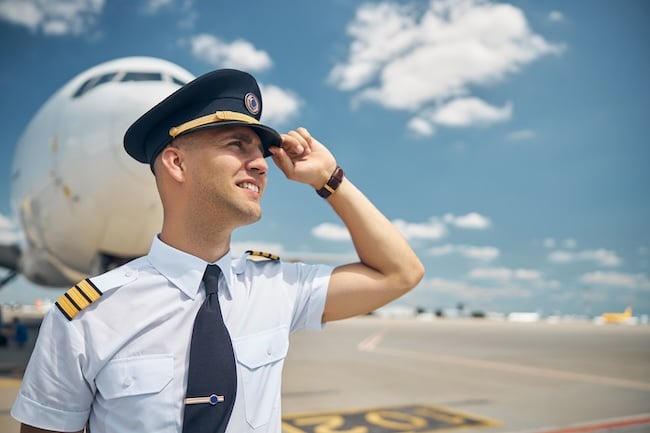Combine this with the high demand for pilots today and in the future, and the opportunities for trainee pilots are exciting, says Jainita Hogervorst, the Director of a Dubai-based Aviation Consultancy.
A unique context for trainee pilots
“Finding pilots is a challenge for airlines at the moment,” says Jainita. The mandatory retirement age of 65, a wave of early retirements, a training bottleneck during COVID, plus an increasing average pilot age mean demand for pilots is high and is forecast to increase,” comments Jainita. According to Boeing’s latest Pilot and Technician Outlook, the industry will need an additional 649,000 new pilots in the next 20 years.
The IATA estimates that there will be 620,000 new pilots by 2037. “So, if you have been considering piloting as a career, there has never been a better time,” Jainita concludes.
Is a career as a pilot right for you?
“Before you sign up for flight school, weighing up the pros and cons is important,” cautions Jainita. “If you want a 9-6, this is not your role.
Plus, it comes with a lot of responsibility. On the positive side, you get a well-paid position with many opportunities.”
First Officers in the US earn from $78,000 to $110,000 (for example, First Officers currently earn $93,605 at American Airlines and Delta).
Pilots with 12 years of experience earn over $300,000 at airlines like Spirit and Alaska. “You will also see a lot of the world, and piloting remains a high-status career,” continues Jainita. If this sounds appealing, Jainita believes it has never been a better time to train as a pilot thanks to 3 factors: more financial support, increased diversity, and advanced technology.
Pilot training opportunity 1: financial support and affordability
“The cost of pilot training holds back many prospective pilots,” Jainita points out. “On average, you will pay around $110,000 for your pilot training. What is exciting is that today, there are more options for financing your pilot training. These range from airlines covering some of your costs to loans and scholarships from flight schools.”
Multiple airlines offer financial support. British Airways’ Speedbird Pilot Academy provides total funding to selected students working for the airline. In the US, Commute Air / United Express ($20,000), Horizon Air ($12,500), PSA Airlines ($15,000), and SkyWest ($17,500) all provide financial reimbursements for training costs.
Other airlines look to remove risk for students, such as Lufthansa, which will reimburse 50% of your training fees if you do not get a job in a Lufthansa Group airline within 24 months of graduating. Flight schools also offer a range of financial options. These include loans to cover most fees after an initial down payment (provided at Lufthansa’s European Flight Academy) or options to split training into modules. Hence, the upfront costs are lower (supplied in the UK at L3Harris Flight Academy). L3Harris also offers selected scholarships.
Pilot training opportunity 2: diversity and inclusion
“Increasing diversity and inclusion in pilot training is another way the industry is tapping into new talent pools,” says Jainita. “Key first steps for flight schools are to pay attention to unconscious biases, provide role models and mentors for students from underrepresented groups, and think carefully about different learning styles,” argues Jainita.
“Financial assistance is vital, and many airlines and associations are taking positive steps in this area.” Initiatives like JetBlue’s Fly Like a Girl, the Organization of Black Aerospace Professionals’ ACE Academy, and the Urban Youth Flight Foundation are introducing young people from diverse backgrounds to piloting as a potential profession.
“Then, when it comes to flight training, airlines and flight schools are improving access,” Jainita points out. The United Aviate Academy by United Airlines is a leading example. In partnership with JPMorgan Chase, the airline offers $2.4 million in scholarships via associations like Women in Aviation International, the Latino Pilots Association, the National Gay Pilots Association, and many others.
It aims to train 5,000 new pilots, with at least 50% women through the school. DELTA’s Propel Collegiate Pilot Career Path Program is another positive example, while Alaska Airlines has partnered with the association Sisters of the Skies.
Pilot training opportunity 3: advanced technology
“Remote training can improve inclusion too,” Jainita comments. “Relocation, rent, and living costs are a significant financial burden for students, so even a few weeks of remote training can make a big difference.” This is precisely what the Native American Aviation Association offers to Native American students in partnership with online flight schools.
“Technologies like VR and AI can accelerate and optimize the learning process, which again means lower total expenditure for students,” comments Jainita. For example, Embry-Riddle Aeronautics University uses a customized VR platform for students to practice tasks like preflight inspections, maneuvers, and radio communications. Students who have used this VR platform are progressing more quickly through their in-plane training. IBM’s FlightSmart tool uses AI to monitor over 4,000 variables in flight simulators and then analyze the data to provide precise, actionable feedback. “Combining VR with AI has exciting potential. It can provide immersive training while monitoring trainees and providing detailed feedback,” comments Jainita. “Overall, these technologies can save students time and money.”
No time like the present
“In light of these three opportunities, my tip to students is to have high expectations and search for the best pilot training packages,” concludes Jainita. “Whether it is new technologies, new inclusion initiatives, or improved financial aid, airlines, flight schools, and governments are all invested in increasing the number of pilots available.
Source: Aerviva
(eTN): Is a Career as a Pilot Right for You? | re-post license | post content























